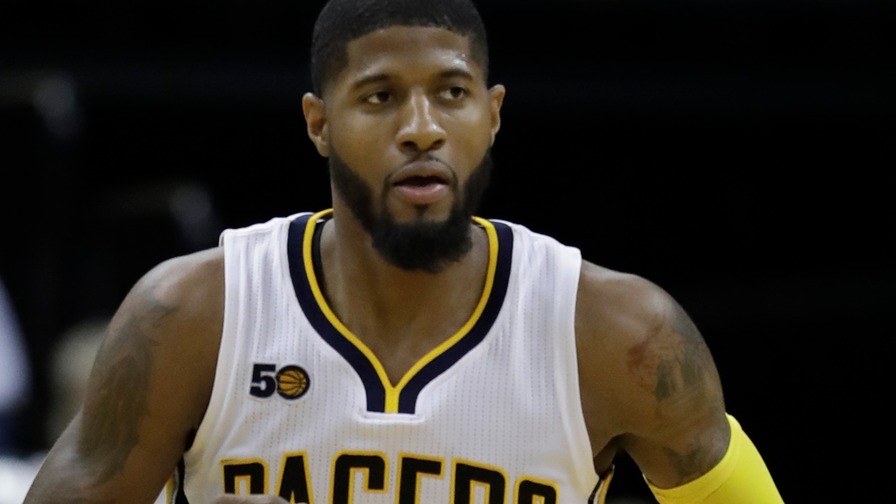Do the Indiana Pacers Need More Paul George?

This past offseason was one quite understandably full of change in Indiana. After going just 45-37 with an early exit from the Eastern Conference Playoffs a year ago, something had to be done.
It all started with the firing of six-year head coach Frank Vogel and the subsequent hiring of former associate head coach Nate McMillan. The expectation was that this shift in leadership would slow the style of play of the Indiana Pacers and bring further discipline to a team once rooted in defensive intensity.
But, that wasn't the only transition the team would need to make. In the offseason, Larry Bird signed veteran Al Jefferson and added Thaddeus Young as well as Jeff Teague via trade. And, so far, that transition has not gone over smoothly.
In their first 20 games, the Pacers finished 10-10, and through 30 games, the Pacers are 15-15 -- confirming their status as an average squad. They may not even be that, as they possess a net rating of -1.59 -- ranked 16th in the NBA.
If they want to get back on track and become the Eastern Conference contenders everyone thought them to be prior to the season, there are a lot of things for them to sort out.
Above all, however, they must first acknowledge the importance of their leader and superstar Paul George.
Losses Versus Wins
In separating the performance of teams in wins versus losses, we can so obviously pick up on the trends between them.
Most of the time, however, we don't have the same exact sample size for both, as we do here. This helps to best differentiate between the outcomes.
| Pacers | Points per Game | FG% | 3PM | 3P% |
|---|---|---|---|---|
| Losses | 98.9 | 42.4% | 6.6 | 30.4% |
In the same way, the Pacers allow other teams to score 114.2 points per game on an effective field goal percentage of 53.8%. For comparison's sake, those numbers would rate 29th and 30th among all 30 NBA teams at this point in time.
In losses, that isn't so alarming. What is disconcerting is the connection between George's play and his team's performance.
| Paul George | Points | FGM | FG% | 3P% |
|---|---|---|---|---|
| Losses | 19.8 | 6.9 | 40.6% | 35.4% |
While George's field goal and three-point attempts per game are rather consistent across both wins and losses, the same can't be said for his other numbers.
Outside of his respectable three-point percentage, nothing appears all that great for a player of George's All-Star caliber.
What's the difference?
| Pacers | Points per Game | FG% | 3PM | 3P% |
|---|---|---|---|---|
| Wins | 110.2 | 48.3% | 9.5 | 40.4% |
In wins, it's almost obvious but, of course, Indiana's scoring more on better percentages and with more three-pointers to boot. The improvement is a reflection of George's same rise in play.
| George | Points | FGM | FG% | 3P% |
|---|---|---|---|---|
| Wins | 23.6 | 8.6 | 48.4% | 40.8% |
In less than a minute more per game, George is adding 3.8 more points to the scoring column while making just under two more shots per game on a much improved percentage from both inside and outside the arc.
Is he shooting more or using more of his team's possessions, though? No, not really.
The 26-year-old is averaging 0.8 more attempts per contest and has a usage rate just 1.2% higher than in his team's losses. Still, in wins, George is contributing more threes, rebounds, assists and steals than he is in his team's losses. He's also turning the ball over less.
Even more of note is that the six-year veteran is accounting for higher percentages in his team's production. Across the board, there is at least a one point rise in his share of field goals made and attempted, three-pointers attempted, rebounds secured, as well as other categories.
All this to say that the more Paul George the better for the Indiana Pacers. And, like I said, it doesn't necessarily mean a lot more shots or a large spike in usage.
More George
While it's understandable that George might be trying to share the love with his new teammates, he has the capability to take over games, as we've seen in the past (particularly, just a year ago) -- and he needs to do more of it.
At times, it will be impossible for him to take over, and that's where his willingness to defer and distribute works to the Pacers' advantage. Then, it's about his teammates making a concerted effort to get him the ball in spots where he can be efficient within the flow of the offense.
A little more Paul George would be great. It's not everything, though. Making sure that he gets his opportunities and that he has the green light to play like the sole focal point of the team, that's key.
After all, George's success is the team's success.
















